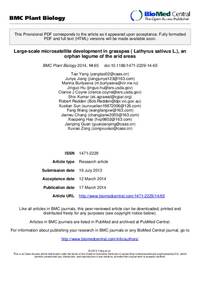Large-scale microsatellite development in grasspea ( Lathyrus sativus L.), an orphan legume of the arid areas

Authors:
Background
Grasspea (Lathyrus sativus L., 2n = 14), a member of the family Leguminosae, holds great
agronomic potential as grain and forage legume crop in the arid areas for its superb resilience
to abiotic stresses such as drought, flood and salinity. The crop could not make much
progress through conventional breeding in the past, and there are hardly any detailed
molecular biology studies due to paucity of reliable molecular markers representative of the
entire genome.
Results
Using the 454 FLX Titanium pyrosequencing technique, 651,827 simple sequence repeat
(SSR) loci were identified and 50,144 nonredundant primer pairs were successfully designed,
of which 288 were randomly selected for validation among 23 L. sativus and one L. cicera
accessions of diverse provenance. 74 were polymorphic, 70 monomorphic, and 144 with no
PCR product. The number of observed alleles ranged from two to five, the observed
heterozygosity from 0 to 0.9545, and Shannon’s information index ranged from 0.1013 to
1.0980, respectively. The dendrogram constructed by using unweighted pair group method
with arithmetic mean (UPGMA) based on Nei's genetic distance, showed obvious distinctions
and understandable relationships among the 24 accessions.
Conclusions
The large number of SSR primer pairs developed in this study would make a significant
contribution to genomics enabled improvement of grasspea.
